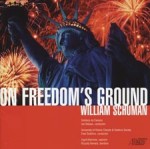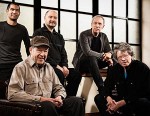Column Name
Title
William Schuman: On Freedom’s Ground. Sinfonia da Camera, University of Illinois Chorale & Oratorio Society; Ricardo Herrera, baritone; Ingrid Kammin, soprano; Ian Hobson and Fred Stolzfus, conductors. (Albany Records, TROY 1280)
This exuberant panorama of William Schuman’s distinguished career includes three works given their first recordings, supplemented by comprehensive, lucid program notes from Joseph W. Polisi, Juilliard’s president and author of American Muse: The Life and Times of William Schuman. The chestnut on the disc, the American Festival Overture (1939), was premiered by Serge Koussevitzky and later championed by Leonard Bernstein, who liked its “energetic drive, a vigor of propulsion which seizes the listener by the hair, whirls him through space, and sets him down at will.” Here conductor Ian Hobson and the Illinois-based Sinfonia da Camera give a suitably celebratory reading to introduce the rarities that follow. The spacious acoustic—present throughout the program—comes from the Krannert Center at the University of Illinois at Urbana-Champaign, with engineering by Christopher Ericson.
Body
Despite Schuman’s considerable achievements as composer and scholar (and as Juilliard’s fourth president, from 1945 to 1961, and subsequently president of Lincoln Center), he was plagued with a degenerative muscle disease that prevented him from serving in the U.S. military at the time of World War II. He channeled his frustration into A Free Song (1942), based on Walt Whitman’s Leaves of Grass. The superb University of Illinois Chorale & Oratorio Society and baritone Ricardo Herrera deliver the Whitman texts with a clarity and ardor that Benjamin Britten might have coveted, with Hobson and the Sinfonia stalwarts behind them. The a cappella Prelude (in a 1942 arrangement for mixed choir) is loosely based on Thomas Wolfe’s novel Look Homeward, Angel, and conductor Fred Stolzfus leads the warmly expressive soprano Ingrid Kammin and the singers in harmonies that evoke the open intervals of chant, occasionally varying the texture with eloquent whispering.
Most ambitious is one of Schuman’s last works, On Freedom’s Ground (1985) for baritone, chorus and orchestra, which he completed for the Statue of Liberty’s 200th anniversary. Instrumental portions recall the edgy energy of the composer’s Symphony for Strings; they’re coupled with probing texts by former U.S. poet laureate Richard Wilbur. But the 40-minute piece is hardly a gung-ho salute to an American icon; Wilbur explores history’s sometimes muted reaction to some of the sacrifices made by the country’s soldiers, and Schuman mines that ambivalence. In the end, idealism wins out in the dramatic culmination with its final phrase, “But we hold our course, and the wind is with us.”
Steve Reich: WTC 9/11, Mallet Quartet, Dance Patterns. Kronos Quartet; So Percussion; James Preiss and Thad Wheeler, vibraphones; Frank Cassara and Garry Kvistad, xylophones; Edmund Niemann and Nurit Tilles, pianos. (Nonesuch 528236)
Efforts to come to terms with the anguish and sorrow of the 2001 terrorist attacks on the World Trade Center have eluded all but a few composers. (John Adams had some success with his Pulitzer Prize-winning 2002 On the Transmigration of Souls, and later this month, Juilliard composition professor John Corigliano will reveal his thoughts with a new work commissioned by the New York Philharmonic.) Now Steve Reich—Juilliard-trained and marking his 75th birthday in October—has tackled what remains, for many people, a wrenching tangle of emotions with WTC 9/11, which received its world premiere at Duke University in March 2011. The piece was written for three string quartets, and the Kronos Quartet (here recorded thrice) starts with the insistent scratchy beep of a phone left off the hook. Using a special technique that modifies words’ final vowels and consonants, Reich places the quartets against a soundtrack of taped radio excerpts from that ill-fated morning, which are chilling in their disbelief and desperation. Texts come from N.Y.C. firefighters, friends and former neighbors of the composer who fled the city that day, and women observing the Jewish custom of shemira—watching over the dead—outside the city’s Medical Examiner’s office. Reich’s pulsing urgency mirrors the panic that unfolded during the unimaginable, and the entire piece ends suddenly—as if it, too, were obliterated without warning.
In the wake of WTC 9/11, the Mallet Quartet (2009) feels like flowers laid on a grave—a gentle, optimistic bloom, expertly gauged by the four members of So Percussion. (A bonus DVD features the four So percussionists in a live performance of the piece.) Completing the CD’s program is Dance Patterns, written in 2002 for Thierry de Mey’s film Counterphrases of Anne Terese de Keersmaeker’s Choreography, which is beautifully realized by a sextet of vibraphones, xylophones, and pianos.
John Kilgore recorded WTC 9/11 at Studio Trilogy in San Francisco, and the other two works at New York’s Avatar Studios, with clarity suiting the transparency of Reich’s textures. As a final note, the cover art originally planned (a gritty image of the second plane headed toward the south tower) generated such controversy that Nonesuch is in the process of replacing it. (At press time, the new image was not available.) For those interested, Reich discussed the album on WNYC's "Soundcheck" and has posted comments on the company’s Web site approving the change, “so we can put the focus back where it belongs, on the music.”






